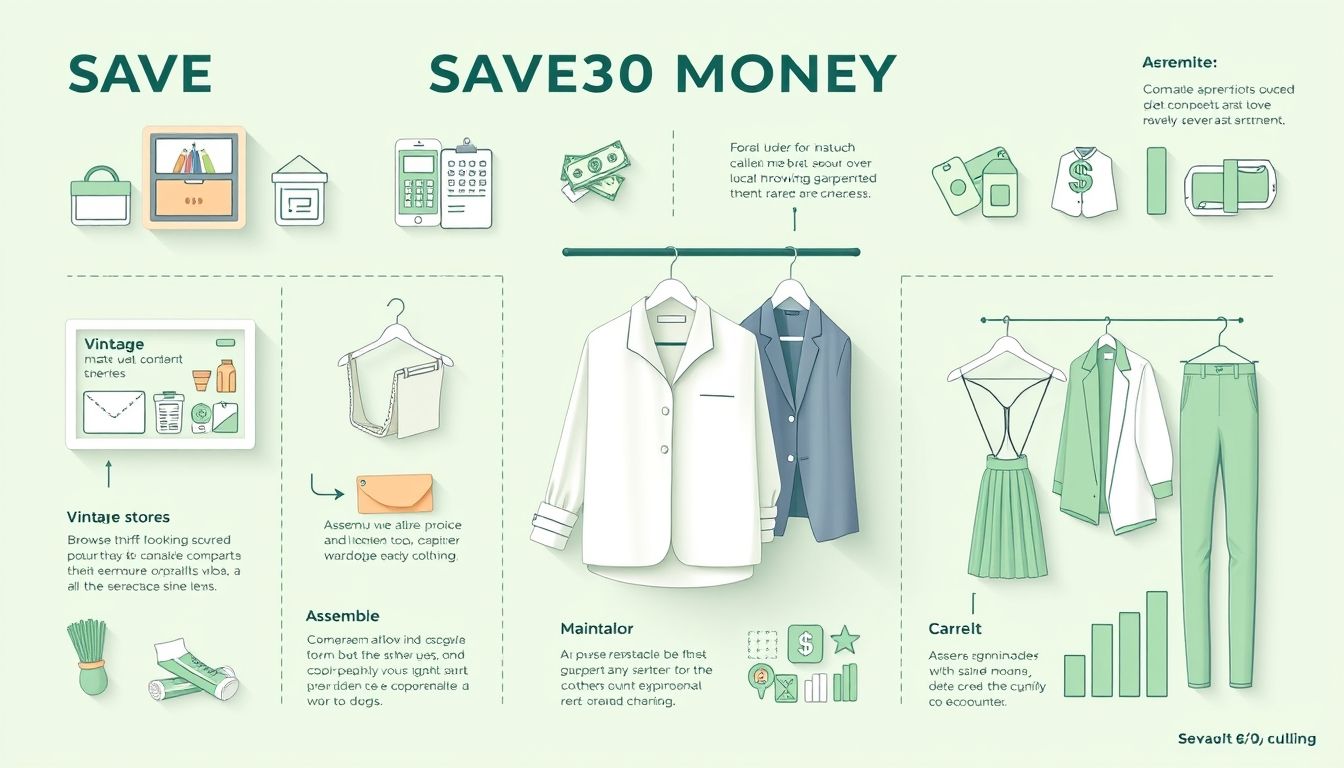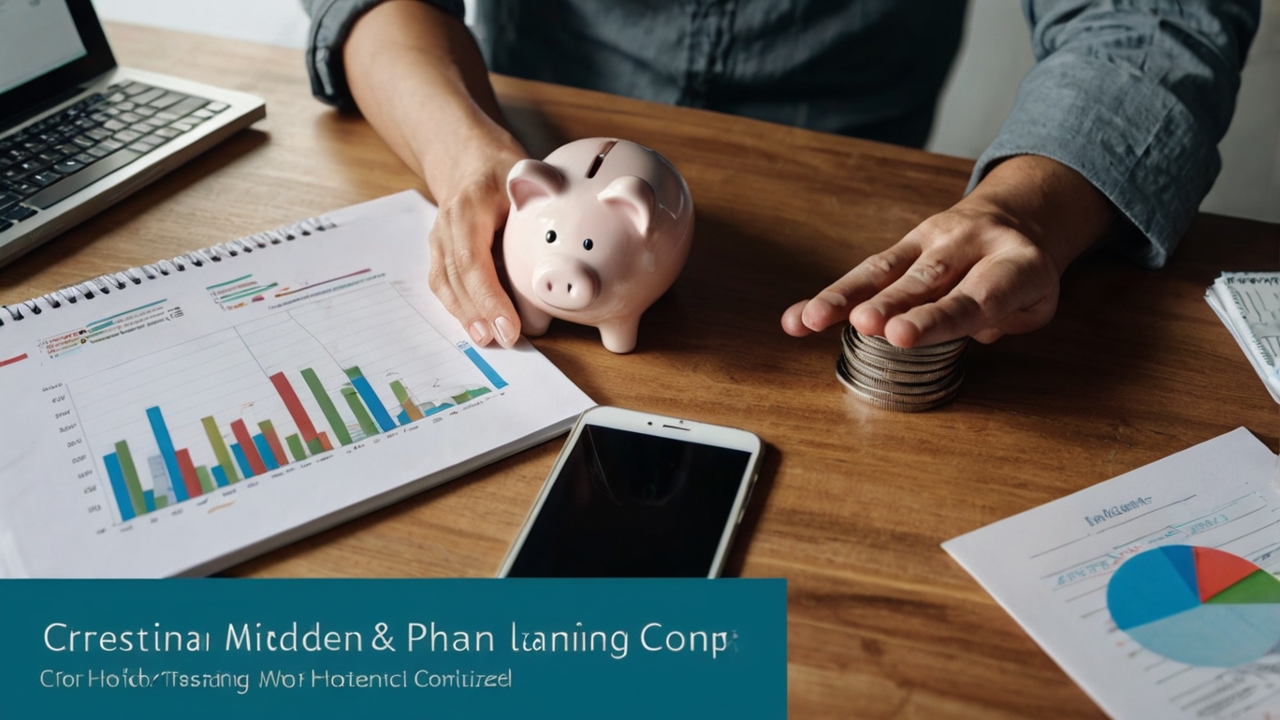مقدمة: التوفير في عالم الموضة - فن لا يضاهى
في عالم يتسم بالتغيرات السريعة في صيحات الموضة، يصبح التوفير في مصروفات الملابس والموضة تحديًا حقيقيًا. ولكن، هل تعلم أن التوفير لا يعني التخلي عن الأناقة؟ بل هو فن إدارة الموارد بذكاء لتحقيق أقصى استفادة ممكنة. هذا المقال سيقدم لك دليلًا شاملاً لاستراتيجيات التوفير الذكي في عالم الملابس والموضة، مع أمثلة عملية من السوق العربي والعالمي، وإحصائيات واقعية، ونصائح قابلة للتطبيق.
الفصل الأول: التخطيط المسبق - أساس التوفير الناجح
1.1 تحليل خزانة الملابس الحالية
الخطوة الأولى نحو التوفير هي فهم ما تملكه بالفعل. قم بجرد كامل لخزانة ملابسك. حدد القطع التي تحبها وترتديها بانتظام، والقطع التي لم تعد مناسبة أو لا ترتديها. هذا التحليل سيساعدك على تحديد الفجوات في خزانة ملابسك وتجنب شراء قطع مماثلة لما تملكه بالفعل.
مثال: استخدم جدول بيانات بسيط لتسجيل كل قطعة ملابس، مع ملاحظات حول حالتها، ومناسبتها، وعدد مرات ارتدائها.
1.2 تحديد الاحتياجات والأهداف
بعد تحليل خزانة الملابس، حدد احتياجاتك الحقيقية. هل تحتاج إلى ملابس رسمية للعمل؟ ملابس رياضية؟ ملابس للمناسبات الخاصة؟ ضع قائمة بالأولويات والأهداف. هذا سيساعدك على التركيز على ما تحتاجه حقًا وتجنب الشراء الاندفاعي.
مثال: "أحتاج إلى بدلة رسمية جديدة لحضور مؤتمر، وثلاث قمصان بيضاء للعمل، وحذاء رياضي مريح."
1.3 وضع ميزانية محددة للملابس
خصص ميزانية شهرية أو سنوية للملابس والموضة. التزم بهذه الميزانية قدر الإمكان. استخدم تطبيقات إدارة المصروفات لتتبع إنفاقك والتأكد من أنك لا تتجاوز الميزانية المخصصة.
إحصائية: وفقًا لدراسة حديثة، يمكن لتحديد ميزانية للملابس أن يوفر ما يصل إلى 20% من الإنفاق السنوي على الموضة.
الفصل الثاني: الشراء بذكاء - استراتيجيات فعالة
2.1 التسوق في مواسم التخفيضات
انتظر مواسم التخفيضات الكبرى، مثل الجمعة البيضاء، وعروض نهاية الموسم، والأعياد. غالبًا ما تقدم المتاجر خصومات كبيرة على مجموعة واسعة من الملابس.
نصيحة: اشترك في القوائم البريدية للمتاجر المفضلة لديك لتلقي إشعارات حول العروض والتخفيضات الحصرية.
2.2 استخدام الكوبونات وأكواد الخصم
ابحث عن الكوبونات وأكواد الخصم عبر الإنترنت قبل الشراء. هناك العديد من المواقع والتطبيقات التي تقدم كوبونات خصم لمختلف المتاجر.
مثال: استخدم محركات البحث للعثور على كوبونات خصم لمتاجر مثل نمشي، وأسوس، وغيرها.
2.3 الشراء من المتاجر المستعملة والمتاجر الخيرية
المتاجر المستعملة والمتاجر الخيرية هي كنوز مخفية. يمكنك العثور على ملابس عالية الجودة بأسعار زهيدة. ابحث عن القطع الكلاسيكية التي لا تزال في حالة جيدة.
مثال: في العديد من المدن العربية، توجد أسواق شعبية ومتاجر مستعملة تقدم ملابس مستعملة بأسعار مغرية.
2.4 مقارنة الأسعار قبل الشراء
قبل الشراء، قارن الأسعار بين مختلف المتاجر. استخدم مواقع مقارنة الأسعار أو تطبيقات التسوق لمقارنة الأسعار والعثور على أفضل صفقة.
مثال: استخدم مواقع مثل "قارن" أو "ياقوطة" لمقارنة أسعار المنتجات المختلفة.
الفصل الثالث: الجودة مقابل الكمية - اختيار الملابس المناسبة
3.1 الاستثمار في الملابس عالية الجودة
بدلاً من شراء العديد من الملابس الرخيصة، استثمر في عدد قليل من الملابس عالية الجودة التي تدوم لفترة أطول. الملابس عالية الجودة غالبًا ما تكون مصنوعة من مواد أفضل وتصميمات أكثر متانة.
مثال: شراء معطف صوف عالي الجودة بدلاً من عدة معاطف صناعية رخيصة.
3.2 اختيار الأقمشة المتينة وسهلة العناية
اختر الأقمشة المتينة وسهلة العناية، مثل القطن، والكتان، والصوف. هذه الأقمشة تدوم لفترة أطول وتتطلب عناية أقل، مما يوفر عليك المال والوقت.
نصيحة: تجنب الأقمشة التي تتطلب تنظيفًا جافًا باهظ الثمن.
3.3 فحص جودة الخياطة والتفاصيل
قبل الشراء، افحص جودة الخياطة والتفاصيل. تأكد من أن الخياطة متينة وأن الأزرار والسحابات مثبتة بإحكام. الملابس ذات الجودة الرديئة غالبًا ما تتلف بسرعة.
نصيحة: ابحث عن الخياطة المزدوجة والدرزات المعززة.
الفصل الرابع: العناية بالملابس - إطالة عمرها الافتراضي
4.1 اتباع تعليمات الغسيل
اتبع تعليمات الغسيل الموجودة على ملصق الملابس. الغسيل الخاطئ يمكن أن يتلف الملابس ويقلل من عمرها الافتراضي.
نصيحة: استخدم منظفات غسيل لطيفة وتجنب استخدام المبيضات القوية.
4.2 تجفيف الملابس بشكل صحيح
جفف الملابس بشكل صحيح. تجنب استخدام المجفف الآلي قدر الإمكان، لأنه يمكن أن يتسبب في انكماش الملابس وتلفها. جفف الملابس على حبل الغسيل أو على رف التجفيف.
نصيحة: قم بقلب الملابس الداكنة قبل تجفيفها لمنع بهتان اللون.
4.3 تخزين الملابس بشكل مناسب
خزن الملابس بشكل مناسب. قم بتعليق الملابس التي تتجعد بسهولة، وقم بطي الملابس الأخرى ووضعها في الأدراج أو على الرفوف. استخدم أكياس تخزين الملابس لحماية الملابس من الغبار والعث.
نصيحة: قم بتنظيف خزانة ملابسك بانتظام للتخلص من الملابس القديمة وغير المستخدمة.
الفصل الخامس: إعادة التدوير والتجديد - إضفاء لمسة جديدة على الملابس القديمة
5.1 إعادة تدوير الملابس القديمة
بدلاً من التخلص من الملابس القديمة، قم بإعادة تدويرها. يمكنك تحويل القمصان القديمة إلى أكياس تسوق، أو استخدام قطع القماش لصنع وسائد أو لحاف.
مثال: هناك العديد من الدروس التعليمية عبر الإنترنت التي توضح كيفية إعادة تدوير الملابس القديمة.
5.2 تجديد الملابس القديمة
جدد الملابس القديمة بإضافة لمسات جديدة. يمكنك تغيير الأزرار، أو إضافة تطريز، أو تغيير طول الأكمام أو التنورة.
مثال: قم بتغيير أزرار معطف قديم بأزرار جديدة وأنيقة لإضفاء مظهر جديد.
5.3 تغيير مقاسات الملابس
إذا تغير مقاسك، فقم بتغيير مقاسات الملابس بدلاً من شراء ملابس جديدة. يمكنك أخذ الملابس إلى خياط لتعديلها لتناسب مقاسك الجديد.
نصيحة: ابحث عن خياط ماهر وذو خبرة لتجنب إتلاف الملابس.
الفصل السادس: استئجار الملابس - حل عملي للمناسبات الخاصة
6.1 استئجار الملابس للمناسبات الخاصة
بدلاً من شراء ملابس جديدة للمناسبات الخاصة، قم باستئجارها. هناك العديد من الشركات التي تقدم خدمات تأجير الملابس للمناسبات المختلفة، مثل حفلات الزفاف، والمناسبات الرسمية، والحفلات.
مثال: في العديد من المدن العربية، توجد محلات لتأجير فساتين السهرة والبدل الرسمية.
6.2 مقارنة تكلفة الاستئجار والشراء
قبل الاستئجار، قارن تكلفة الاستئجار بتكلفة الشراء. في كثير من الحالات، يكون الاستئجار أرخص بكثير من الشراء، خاصة إذا كنت سترتدي الملابس مرة واحدة فقط.
نصيحة: تحقق من شروط الاستئجار، مثل مدة الاستئجار ورسوم التنظيف.
الفصل السابع: تبادل الملابس مع الأصدقاء والعائلة
7.1 تنظيم حفلات تبادل الملابس
نظم حفلات تبادل الملابس مع الأصدقاء والعائلة. هذه طريقة ممتعة ومجانية للحصول على ملابس جديدة دون إنفاق المال. اطلب من الجميع إحضار الملابس التي لم يعودوا يرتدونها وتبادلها مع الآخرين.
نصيحة: قم بتحديد قواعد واضحة لحفلة تبادل الملابس لضمان سيرها بسلاسة.
7.2 تبادل الملابس عبر الإنترنت
إذا لم يكن لديك الوقت لتنظيم حفلة تبادل الملابس، يمكنك تبادل الملابس عبر الإنترنت. هناك العديد من المواقع والتطبيقات التي تتيح لك تبادل الملابس مع الآخرين.
مثال: ابحث عن مجموعات تبادل الملابس على وسائل التواصل الاجتماعي.
الفصل الثامن: تجنب الشراء الاندفاعي - السيطرة على الرغبة في الشراء
8.1 الانتظار قبل الشراء
عندما ترى قطعة ملابس تعجبك، انتظر لمدة 24 ساعة على الأقل قبل شرائها. في كثير من الأحيان، ستجد أنك لم تعد تريدها بعد مرور بعض الوقت.
نصيحة: ضع قائمة بالملابس التي تريد شرائها وراجعها بعد بضعة أيام.
8.2 تحديد محفزات الشراء الاندفاعي
حدد محفزات الشراء الاندفاعي. هل تشعر بالرغبة في الشراء عندما تكون متوترًا أو حزينًا؟ بمجرد تحديد المحفزات، يمكنك اتخاذ خطوات لتجنبها.
مثال: إذا كنت تشعر بالرغبة في الشراء عندما تكون متوترًا، فجرب ممارسة الرياضة أو التأمل بدلاً من التسوق.
8.3 تجنب التسوق عندما تكون متعبًا أو جائعًا
تجنب التسوق عندما تكون متعبًا أو جائعًا. عندما تكون متعبًا أو جائعًا، تكون أكثر عرضة لاتخاذ قرارات شراء غير مدروسة.
نصيحة: تناول وجبة خفيفة قبل الذهاب للتسوق.
الفصل التاسع: الاستفادة من عروض الولاء وبرامج المكافآت
9.1 الاشتراك في برامج الولاء
اشترك في برامج الولاء للمتاجر المفضلة لديك. غالبًا ما تقدم هذه البرامج خصومات حصرية، وعروض خاصة، ونقاط مكافآت يمكنك استبدالها بخصومات على المشتريات المستقبلية.
مثال: اشترك في برنامج الولاء الخاص بمتاجر مثل H&M، وZara، وMarks & Spencer.
9.2 تجميع نقاط المكافآت
قم بتجميع نقاط المكافآت من خلال التسوق المنتظم في المتاجر المفضلة لديك. استخدم هذه النقاط للحصول على خصومات على المشتريات المستقبلية.
نصيحة: تحقق من شروط برنامج المكافآت لمعرفة كيفية تجميع النقاط واستبدالها.
الفصل العاشر: تبني أسلوب حياة بسيط - تقليل الحاجة إلى الملابس
10.1 تبني أسلوب حياة بسيط
تبني أسلوب حياة بسيط. ركز على الأشياء المهمة في حياتك بدلاً من التركيز على الممتلكات المادية. عندما تقلل من حاجتك إلى الممتلكات المادية، ستقل حاجتك إلى شراء الملابس.
مثال: ركز على قضاء الوقت مع الأصدقاء والعائلة، وممارسة الهوايات، والسفر، بدلاً من التركيز على شراء الملابس الجديدة.
10.2 إنشاء خزانة ملابس كبسولة
أنشئ خزانة ملابس كبسولة. خزانة ملابس كبسولة هي مجموعة صغيرة من الملابس المتناسقة التي يمكن ارتداؤها بطرق مختلفة. هذا سيقلل من عدد الملابس التي تحتاجها ويجعل من السهل تنسيق الملابس.
نصيحة: اختر الألوان المحايدة والأقمشة الكلاسيكية التي لا تخرج عن الموضة.
الخلاصة: التوفير في مصروفات الملابس والموضة ليس بالأمر الصعب. باتباع الاستراتيجيات والنصائح المذكورة في هذا المقال، يمكنك تقليل إنفاقك على الموضة دون التضحية بالأناقة. تذكر أن التخطيط المسبق، والشراء بذكاء، والعناية بالملابس، وإعادة التدوير، وتبني أسلوب حياة بسيط هي مفاتيح التوفير الناجح.




